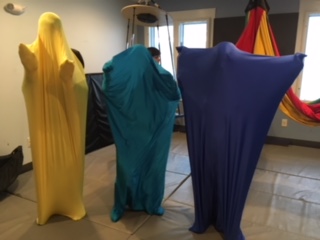
Have you ever felt overwhelmed and found yourself needing to take a break, re-calibrate, before you’re ready to tackle a challenge or try something new? For children and youth with behavioral health needs, particularly those who have experienced complex trauma, figuring out how to calm themselves, or self-regulate, can be very challenging. That’s where sensory materials can play an important role.
Thanks to a generous three-year $50,000 grant from the KeyBank Foundation, young people with behavioral health challenges living at Spurwink are finding new tools and coping strategies to calm themselves. “Spurwink has an innovative approach to delivering programming for children and adolescents with emotional/behavioral disabilities who are unable to live safely at home or be successfully treated in a less restrictive environment,” said Brigitte Ritchie, Corporate Responsibility Officer with KeyBank. “We are proud to partner with an agency that is as impactful as Spurwink is in giving children the ability to live healthy and engaged lives in the community.”
Over the past year, Willow House in Portland has been equipped with a wide range of sensory integration and gross motor equipment in new sensory rooms. Sensory and gross motor equipment, like indoor swings, hammocks, and body sleeves, can help children with behavioral health challenges learn to regulate their own behavior. Our clinical and residential teams work with children and youth to help them identify their stressors, and utilize sensory and gross motor equipment to self-regulate so that they can get back to playing with peers and other meaningful engagement at home and in school.
It’s making a huge difference in the lives of kids.
In 84% of cases where children were experiencing episodes of dysregulation, children were able to use coping strategies and sensory materials to effectively calm themselves.
The sensory rooms and equipment are helping kids:
- Regulate more independently instead of relying on the co-regulating help from staff.
- Increase social interactions. Staff noted that kids have more functional interactions with peers in that space than any other room in the house, engaging in positive conversation and exchanges.
- Communicate their feelings more effectively with staff. Kids seem to be willing to talk more to staff about what is bothering them when or after they have engaged in a sensory activity.
And the good results don’t stop there. With KeyBank’s support, we are expanding the Willow House pilot throughout our residential programs, using the data on which equipment is having the best results to inform sensory room equipment in our other residences. We’ll also be sharing the information with families so that they can help their children regulate more effectively in their own homes.
Interested in helping youth with behavioral health needs learn how to self-regulate and re-engage with learning? You can follow KeyBank’s lead by making a donation of any size to help Spurwink purchase additional sensory and gross motor equipment for children and youth in our residences and schools.
